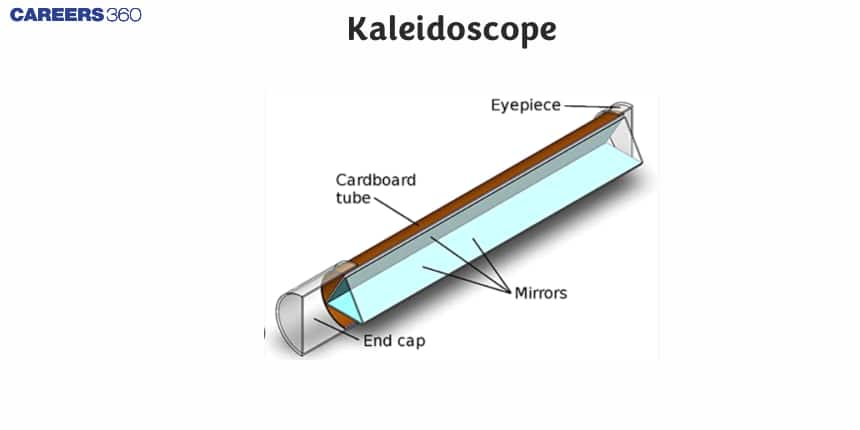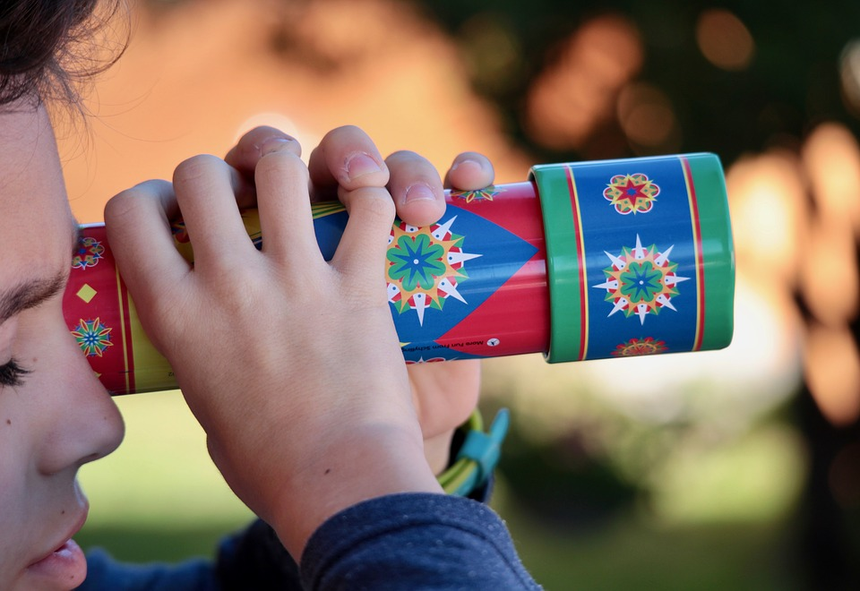Kaleidoscope - Principle, Uses, FAQs
A Kaleidoscope is an optical instrument that creates stunning, symmetrical patterns through the reflection of light off mirrors arranged inside a tube. It works by reflecting colorful objects like beads, which change as the tube is rotated. These endless patterns are not only visually captivating but also inspire creativity in art and design. From this article, let us try to understand the kaleidoscope in detail.
This Story also Contains
- What is a kaleidoscope?
- Principle of Kaleidoscope
- How To Make Kaleidoscope?
- Types of Kaleidoscopes
- How many images are seen in a kaleidoscope?
- Uses of Kaleidoscope in Real Life

Also read -
What is a kaleidoscope?
A kaleidoscope is one of the optical instruments that contains two or more than two reflecting surfaces. These reflecting surfaces are titled in such a way that they face each other at an angle with a symmetrical pattern. The Kaleidoscope instrument contains a tube with reflecting surfaces consisting of pieces of glass. When the tube is rotated, many symmetrical images are formed and give a beautiful look.
The word kaleidoscope is taken from the combination of ancient Greek words such as “kalos”, “eidos” and “skopeo” which means “ beautiful beauty”, “that which is seen” and “to look”. The kaleidoscope was invented by a Scottish inventor, David Brewster in the year of 1817. In this optical instrument, the sunlight is bounced back by the color glasses and gets reflected by the mirrors to form unique picture patterns for the viewers.
Principle of Kaleidoscope
Kaleidoscope is based on the principle of multiple reflections of light within a closed chamber of mirrors. The below points show the work principle in detail:
Reflection of Light: A kaleidoscope is generally made up of three rectangular mirrors joined together to form a triangular structure. Because the light goes in from one end, it bounce off on the faces of the mirrors.
Multiple Reflections: The mirrors are arranged at particular orientations (in most cases; 60°) to produce various types of reflection patterns. The light slips back and forth between the mirrors and in the process the placed object at the open end creates multiple images.
Formation of Patterns: The reflections are in parabolic forms, and are mirrored in such a way that as the object or objects placed in the chamber are usually colorful glass pieces or beads the designs formed are very much like a kaleidoscope.
Human Perception: As a result, multiple reflections are observed as patterns when you look through the eyepiece and appear as beautiful designs. Every time one of them shifts, the arrangement of the objects inside somehow alters, forming new and different formations.

|
Related Topics |
How To Make Kaleidoscope?
Now, let us see the making and discuss how to make a kaleidoscope in home. To make a kaleidoscope we require some things that are listed below:
- Colored plastics
- Mirrored perspex
- Pencil
- tape
- Overhead transparency paper
Below steps shows the process of Construction of kaleidoscope
- Take three numbers of mirrored perspex roll them with the help of the tape and form them in the shape of a triangle. Check and verify the firmness of the perspex and also tape it from the outside of the triangle.
- Draw a small triangle which is located at the edge of the overhead transparent paper. In excess of that, set 1 cm around the triangle to allow the paper to fold.
- Place the transparent paper on the edge and also make some small openings at the edges. This makes the folding at corners easy. Attach the transparent paper into a separate place.
- Draw and create another triangle and make the triangle 2 cm bigger than the previous one.
- Choose the color of the plastic as per your preference, and put that plastic inside the kaleidoscope. Paste small paper cuttings on the transparent paper.
- Put the colored plastics at the kaleidoscope end which has the transparent paper in it and later add another transparent paper over it like a triangle. The second paper should be placed upside down so that some space will be created for the colored plastic to move inside.
- You can cover the kaleidoscope and decorate it with different colors and so on.
Types of Kaleidoscopes
Kaleidoscopes are mainly of three types:
1. Teleidoscope
- Uses a lens at the end instead of coloured pieces.
- It forms patterns from objects outside the tube.
2. Dry-cell Kaleidoscope
- Contains dry coloured pieces (glass, beads, paper).
- Patterns change when the tube is rotated.
3. Oil-cell Kaleidoscope
- Contains coloured pieces floating in liquid (oil).
- The motion is slower and patterns change smoothly.
How many images are seen in a kaleidoscope?
In a kaleidoscope, the number of images formed is many, and they appear as beautiful repeated patterns.
The exact number of images depends on the angle between the mirrors inside the kaleidoscope.
Rule (Class 8 level):
Number of images $=360^{\circ} \div$ angle between the mirrors
Since most kaleidoscopes use three mirrors placed at $\mathbf{6 0}^{\boldsymbol{\circ}}$, we get:
$360^{\circ} \div 60^{\circ}=6$ images
So a typical kaleidoscope shows six repeated images, forming colourful symmetrical patterns.
But in general :
A kaleidoscope forms many multiple reflections and creates beautiful patterns.
Uses of Kaleidoscope in Real Life
- Designers utilize a kaleidoscope to create symmetrical and complex designs on fabrics.
- It facilitates development of designs that have symmetric designs and creativities needed in ornaments.
- Applied for producing various artistic effects in photos and motion pictures.
- Explains the principles of reflection and symmetrical line and axis of symmetry.
- The patterns which are formed in a kaleidoscope are used in the field of fashion designing.
- Kaleidoscopes are commercially sold in the market as entertainment toys.
Frequently Asked Questions (FAQs)
Plane mirrors are used in kaleidoscope
Generally, two numbers of plane mirrors are used in the construction of simple kaleidoscope.
Kaleidoscope is one of the optical instruments which contains two or more than two reflecting surfaces. These reflecting surfaces are titled in such a way, it faces each other at an angle with a symmetrical pattern. The Kaleidoscope instrument contains a tube with reflecting surfaces consisting of pieces of glass. When the tube is rotated, many symmetrical images are formed and give a beautiful look.
Kaleidoscope is considered to be an optical toy that contains two mirrors at some particular angle and produces beautiful images while the tube in the instrument is rotated.
The patterns which are formed in a kaleidoscope are used in the field of fashion designing.
Also this kaleidoscope is used as a toy for children and these kaleidoscopes are commercially sold in the market as entertainment toys.
When the white light from the source falls on the surface of the mirror, the incident white light is reflected at an angle which is equal to the angle of the incident. Thus the angle of incidence and angle of reflection of the white light is equal to each other. And the presence of the glasses and mirrors cause multiple reflections inside the kaleidoscope. The beautiful image patterns are created due to this multiple reflection formed inside the kaleidoscope. When the white light from the source falls on the surface of the mirror and other glasses, the most part of the light gets absorbed by the mirrors and colored glasses.
Take three numbers of mirrored perspex and roll them with the help of the tape and form it in a shape of triangle. Check and verify the firmness of the perspex and also tape it from the outside of the triangle.
Draw a small triangle which is located at the edge to the overhead transparent paper. In excess of that, set 1 cm around the triangle to allow the paper folding.
Place the transparent paper on the edge and also make some small openings at the edges. This makes the folding at corners easy. Attach the transparent paper into a separate place.
Draw and create another triangle and make the triangle 2 cm bigger than the previous one.
Choose the color of the plastic as per your preference, and put that plastic inside the kaleidoscope. Paste small paper cuttings on the transparent paper.
Put the colored plastics at the kaleidoscope end which has the transparent paper in it and later add another transparent paper over it like a triangle. The second paper should be placed upside down, so that some space will be created for the colored plastic to move inside.
You can cover the kaleidoscope and decorate it with different colors and so on.